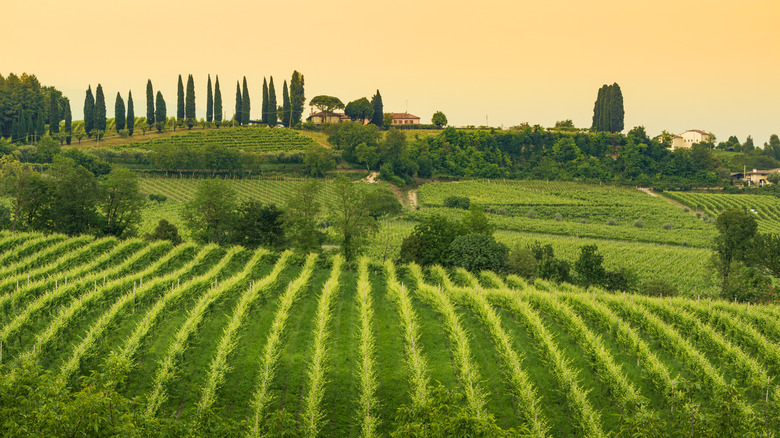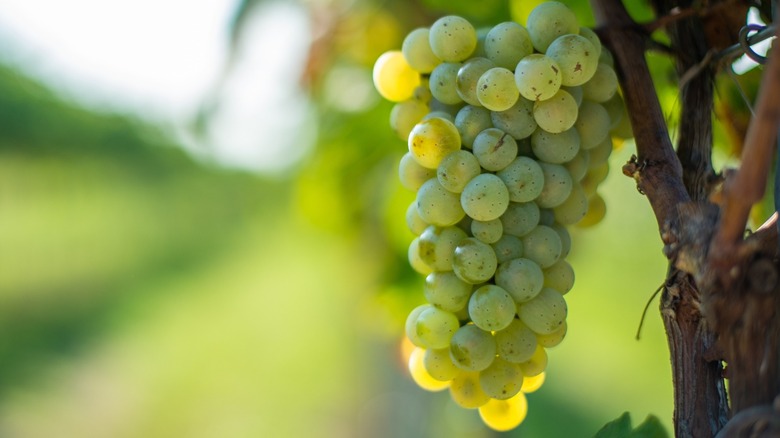Prosecco Vs Secco: What's The Difference Between These Wines?
For anyone who has ever been confused by the subtle differences between all the different types of sparkling wine, Prosecco and secco seem like they were made to mess with you. Wine is already difficult enough to parse with all the different regions, names, and grapes that may create only small variations in the actual experience of drinking them, so to take a wine like Prosecco that many people in the U.S. have only learned about in the last decade or two and introduce another whose name is almost identical is just cruel. You probably just learned the difference between Champagne and Prosecco, and now this? Sometimes, all the stress it takes to figure out your wines makes you really need a glass of wine.
Don't be fooled by the names, though. Secco is not just a type of Prosecco, or even a nickname for it, it's a whole different thing. It comes from a different country, it's made differently, and it doesn't taste the same. The similar names only come from the fact that one of them is trying to reference the other. One thing they have in common, though, is that both are light sparkling wines — but even that is going to get complicated. The second thing they have in common is that you will want to snag a bottle of both when you're done here, because Prosecco and secco are entire worlds unto themselves to explore.
What is Prosecco?
Prosecco is a naturally carbonated sparkling wine from Italy. Specifically, it is made in northeastern Italy, outside of Venice. It's generally a cheaper variety of sparkling wine compared to alternatives like Champagne because of the unique way it's produced. Unlike other sparkling wines, which undergo a second fermentation that creates carbonation in the bottle, Prosecco's second fermentation happens in large vats, where yeast and sugar are added to trigger the process. This special form of production is faster and less labor intensive than that of other wines, making Prosecco more affordable. Prosecco is almost always a white wine, however, rosé versions are made as well.
Like any wine, Prosecco's flavor can vary by vineyard, but, in general, it is a very light, crisp sparkling wine with bright fruit flavors. It can run across a wide range of sweetness, from dry, which is the most sweet, to extra brut and ultra brut, which are the least. Italy categorizes its sparkling wine by the amount of carbonation, and most Prosecco falls into the spumante category, which is the most bubbly. It is also relatively low in alcohol compared to most wines, with an alcohol by volume (ABV) of around 12%. Other wines, for example, can reach an ABV of up to 14.5%. Besides being a common, refreshing sipper, Prosecco's light flavor and carbonation make it popular for mixing in a great selection of sparkling wine cocktails, and it's one of the main ingredients in the classic Aperol Spritz.
What is secco?
Secco is an odd name in the wine world. Unlike Prosecco, wines labeled "secco" come from Germany, but the secco name is inspired by the Italian Prosecco. However, secco is a much more broad term than its Italian inspiration. It's a label applied to a certain category of German sparkling wines that are also called perlwein. These wines are what is known as "semi-sparkling," which just means that they have less carbonation than full sparkling wines. This differentiates them from sekt, which are the German versions of fully sparkling wines, similar to Champagne. Another thing that makes secco unique is that it can either be naturally carbonated or force-carbonated, where the carbonation is added in after fermentation. This is not the case for many other sparkling wines.
Beyond being semi-sparkling, there is no fixed definition for seccos. They are light, refreshing, and low in alcohol, but there are no legal limits on what may be labeled secco. Because there are no protections for secco, or perlwein, its quality can vary greatly, and it is known as a relatively cheap wine. These budget prices are aided by the fact that in Germany, semi-sparkling wines are subject to a lower tax than full sparkling wines like Prosecco. So, secco is essentially a catch-all term for generic, usually cheap, semi-sparkling German wine from a variety of sources.
Prosecco must be made in one area of Italy
Like its French relative Champagne, Prosecco's name is protected by law, and it may only be produced in certain regions of Italy. This is the European and Italian wine labeling practice of DOC, which means Denominazione di Origine Controllata, or "controlled designation of origin," which is used to ensure that traditional foods and drinks retain consistent quality and can't be devalued by cheap imitations with the same name. Prosecco can only be made in nine provinces within two northern Italian regions, Veneto and Friuli-Venezia Giulia.
Prosecco is actually named after the village of Prosecco near the Adriatic Sea. The unique microclimate of the Prosecco region between the sea and the nearby Dolomite Mountains is part of what contributes to the wine's fresh fruity taste. Any bottle that is real Prosecco from this area should have a clear DOC label to authenticate it. In fact, there are two even more specific labels you may see, Prosecco DOC Treviso and Prosecco DOC Trieste, which can only be used if all of the grapes, winemaking, and bottling happen in those two provinces.
Secco and perlwein have no such legal restrictions to verify where they are made. Other than generally coming from German-speaking regions, including Austrian wine country, secco can be made anywhere. There are some perlweins that are considered higher quality and have a protected origin label, but the term itself is not regulated, so even with those their origins are less certain.
Secco can be made from a variety of grapes
Similar to how secco can come from any region, there is also no defined grape or mix of grapes needed to make a wine into secco or perlwein. Because many German sparkling wines like secco or sekt have no legal definition, Germany produces sparkling wine from a wide variety of grapes. Popular sparkling wine grapes like Chardonnay and Pinot Blanc are used, but the most common grape in the country is the classic, easily preserved white wine grape variety Riesling, which is preferred for its fresh, light flavor. Prosecco, meanwhile, is based on one variety of grape named Glera, although in the past they were also just called "Prosecco grapes."
Glera is a thin-skinned wine grape that has been grown in northern Italy for centuries, and is famous for its thick bunches of golden-yellow grapes. All Prosecco must be made with mixes that are at least 85% Glera grapes, although some vineyards may make versions that are up to 100%. Glera is favored for its medium-high acidity, which is considered ideal for sparkling wines. It is also a highly productive wine grape that can produce a neutral flavor. Other grapes that are used in Prosecco mixes with Glera include Chardonnay, Pinot Bianco, and Pinot Grigio. Even the newer sparkling rosé versions of Prosecco use Glera, and get their color from skin-on Pinot Noir grapes.
Prosecco has a distinctive lightly fruity, crisp flavor
Prosecco is well-known for its extremely crisp flavor and pleasant drinking experience. It gets its unique perfume and flavor from the Glera grapes, which produce notes of fresh fruit such as apples, pears, and melon, as well as floral flavors like jasmine. The unique tank system used to produce Prosecco also adds to the taste, as it better preserves softer fruit flavors. One area of flavor where you'll have to go off the label is the sweetness, as Prosecco can vary greatly by producer. And while most Prosecco is highly sparkling, there are some semi-sparkling styles as well, labeled frizzante. Carbonation is measured in bars, and frizzante sparkling wine falls in the 1 to 2.5 bar range, while fully sparkling spumante is 5, similar to Champagne.
Because of its incredibly varied production, the flavor of secco will be harder to predict, but it is considered a lightly flavored, refreshing wine. Seccos can have a strong fruit taste, comparable to an aged cider. However, they are usually more on the dry side. The most notable aspect of secco is that it is always semi-sparkling, falling in the same 1 to 2.5 bar range as frizzante Prosecco. Seccos are best served cool as an easy drinking wine perfect for a hot day or an aperitif to a meal.





